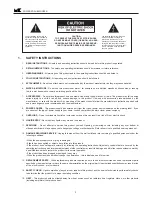
B.
Locate the subwoofer.
1.
The best place for the subwoofer is the corner with the best structural strength. If the corners
are roughly equal in construction, use the corner nearest the listening position. If the listening
position is in the front half of the room, place the subwoofer in a front corner. If it is in the back
of the room, place the subwoofer in a back corner. If possible, avoid corners near doorways
or openings.
2.
If you are willing to experiment, another option is to place the subwoofer at the listening
position and walk around the room. Stand in and near each corner. The location where you
hear the tightest bass with the most impact is probably the best location in the room for the
subwoofer.
3.
If multiple subwoofers are used, place them in the same location. Stacking is best, but you
can also put them side by side.
Another option for multiple subwoofers is to place them in different locations. This is appropriate when
you have limited choices in locating the subwoofer and none of the available locations work well. Try
to place multiple subwoofers at equal distances from the listening position to avoid phase cancellation.
C.
Locate the surrounds. Determine the best position in the room. It will probably be the position used
for THX speaker, directly to the right and left of the main listening position on the side walls (so that a
listener in the center seat is directly between the speakers). If that doesn’t work or is not practical
because of the room, try these locations: on the ceiling; on the back wall, or in the back corners (using
an M&K ST Corner bracket).
D.
Install all wiring and interconnects.
E.
Aim the front speakers (this is a must for THX front speakers). Use a laser level to align each
speaker. Place the level on the flat surface between the midranges and tweeters that is roughly in the
center of the front baffle. The red dot of the laser should be aligned to the center of the listener’s fore
head at ear height. Make sure that the volunteer who sits in the main listening position keeps their eyes
closed!
Make sure that you aim the left and right speakers in both the horizontal and vertical planes. Horizontal
toe-in is important for the best possible imaging.
F.
If you have a Dolby Digital AC-3 5.1 channel processor/receiver, follow these instructions. If you have
a Pro-Logic processor/receiver, go to item 7 below.
SPECIAL NOTE: Always check the processor/receiver’s owner’s manual. Different manufacturers use different
descriptions for the same function, and sometimes the same description for different functions!. Your
component may use terminology different from that used below.
1.
High-Pass Filters: All Dolby Digital processor/receivers have built-in high-pass filters for the
Left, Center, Right, Left Surround, and Right Surround channels. Always turn these filters ON
by using the SMALL setting. If you have a THX component, use the THX setting. See the
owner’s manual of the processor/receiver for instructions.
2.
Bass Management: If the processor/receiver has a setting to turn the Subwoofer off or on,
make sure that it is set to SUBWOOFER YES or ON.
3.
Dialog Normalization: If your component has this function, turn it off to avoid any possible
effect on sound quality.
4.
THX Dolby Digital units have an adjustable limiter for the subwoofer feed, called “Bass Peak
Level Management”. Turn it off, or set it for the highest possible level. M&K subwoofers do
not need this limiter.
POWERED SUBWOOFER
13

































